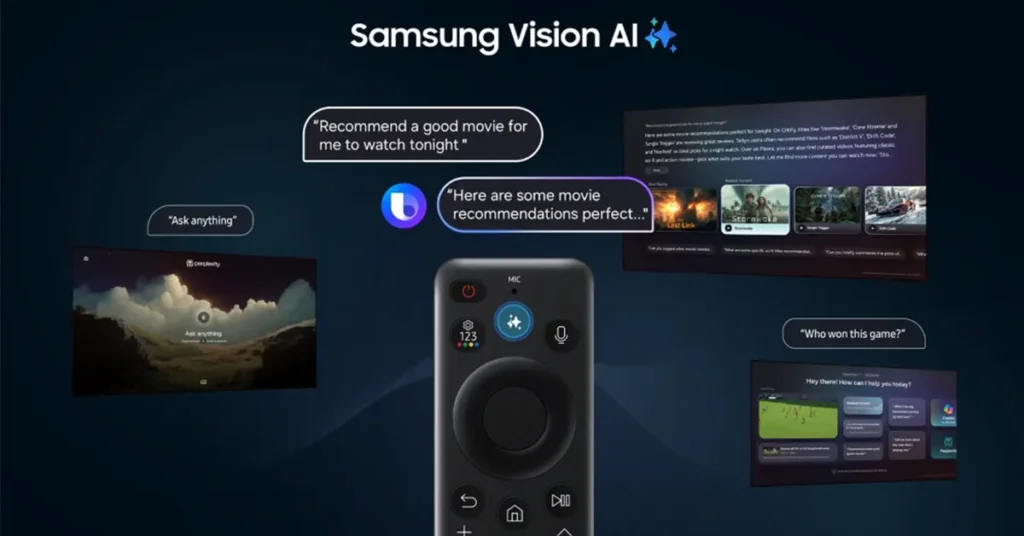The TV has always been the living room anchor. With Samsung Vision AI Companion, it graduates from a passive screen to an active co-pilot. Samsung Vision AI Companion brings natural, two-way conversation to the biggest display in the house, helping families ask questions, plan nights in, surface smarter recommendations, and even manage tasks, all without juggling menus or second screens.
In This Article
What is Vision AI Companion
Built for the shared screen, not a single user’s phone, Vision AI Companion (VAC) is designed to spark conversation among everyone on the sofa. Ask about the actor on screen, pull trivia for a movie night, plan a family dinner, or queue up a recipe video. The assistant responds in context with helpful visuals, so you keep watching while the answers arrive.
At the core is an upgraded version of Bixby that supports more natural dialogue, better context retention and personalised responses. Instead of memorising commands, viewers simply talk. Ask about a match, a painting, a travel idea or a product review, then follow up with clarifying questions. VAC keeps pace and keeps things on screen.
Read Also: Jio users can claim an 18-month Google AI Pro subscription for free: Here’s how
World’s first multi-AI agent TV platform
Samsung positions VAC as an open, multi-AI agent platform that taps LLMs such as Microsoft Copilot and Perplexity to assemble visual, structured responses. Press the AI button on the remote to open a new kind of search experience made for the TV. Results arrive neatly organised with options like personalised recommendations, trip planning and deeper research. It works across Live TV, Samsung TV Plus and major streaming apps, so the assistant stays helpful no matter what you are watching.
Why it matters: the multi-AI agent TV approach lets the system route your question to the right model, then present an answer that fits a lean-back screen. That makes complex queries feel effortless in a living room context.
Conversational and visual intelligence
Powered by Generative AI, VAC understands context and follow-ups, delivering answers with on-screen cards and imagery. No typing. No app-hopping. Just talk to your TV.
Practical examples:
-
“What is the best way to grill pork belly?” The TV lines up step-by-step recipe videos.
-
“Can you recommend a movie for Christmas?” It suggests festive picks with synopses and related content.
-
“What is the weather like in December?” You get up-to-date forecasts while your show keeps playing.
Features built for the living room
-
Live Translate: Real-time translation of on-screen dialogue and conversations for global households. The phrase live translate Samsung lands as a headline feature for cross-language viewing.
-
AI Gaming Mode: Smarter picture and sound tuning for responsive play. Expect the AI gaming mode TV promise to matter to console and cloud gamers.
-
Generative Wallpaper: Dynamic, personalised screens that match mood and taste, making generative wallpaper TV more than a screensaver.
-
AI Picture, AVA Pro and AI Upscaling Pro: Automatic optimisation that sharpens visuals and dialogue, with AI Upscaling Pro lifting lower-resolution content.
Languages, platforms and longevity
With one of the broadest language offerings on a TV or monitor, VAC supports 10 languages, including Korean, English, Spanish, French, German, Italian and Portuguese. It ships across Samsung’s 2025 lineup: Neo QLED, Micro RGB, OLED, QLED step-up TVs, Smart Monitors and The Movingstyle. Vision AI Companion runs on One UI Tizen, with seven years of OS software upgrades for security and feature continuity.
Availability and the value pitch
By centring AI on the communal screen, Samsung aims to make the assistant feel like part of movie night, game day and family planning. The multi-AI agent TV design, combined with an upgraded Bixby voice, helps the experience feel intuitive rather than intrusive.
Read Also: Spotify users can now share content through WhatsApp on their Android devices
Vision AI Companion does not try to replace the phone. It respects the living room’s vibe and adds intelligence where it counts. If Samsung sustains language coverage and keeps responses fast and relevant, this could be the moment when talking to your TV finally feels natural.




